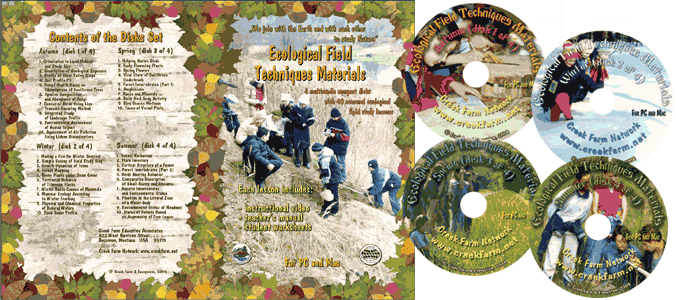|
| Our Field Ecology Center published more than
180 methodical materials for nature studies. Some of them are in English: |
|
|
|
Study of Species Composition and Census of Birds Using
the Line Transect-counting Method
© Alexsander S. Bogolyubov,
Russia, 1999
© Michael J. Brody, USA,
2003
 This manual contains a simplified procedure of
line-transect census of birds, which includes line-transect selection, technique for
line-transect counting and field diary record keeping. It also includes the estimation of
bird population density based on the line-transect count results. This manual contains a simplified procedure of
line-transect census of birds, which includes line-transect selection, technique for
line-transect counting and field diary record keeping. It also includes the estimation of
bird population density based on the line-transect count results.
This field study has instructional video
featuring real students conducting the ecological field techniques in nature. Each video
illustrates the primary instructional outcomes and the major steps in accomplishing the
task including reporting the results.
Introduction
The essence of this research is for students to conduct line-transect counts of birds
with further estimation of each species' density per one square unit (square kilometer) in
the selected habitat. During autumn, this study is not difficult to carry out because
birds' biodiversity and their number in this season are usually not great (at least in the
forest zone).
Before starting the count, a habitat should be selected where the counting will
take place. A light thin forest habitat not less than 1 square kilometer is recommended
for best results.
There are several methods of bird counting used in zoogeographical and
ornithological studies today. They differ in complexity and accuracy of real density
estimations.
The methods can be divided into three large groups: site, point and line-transect. Site
and point methods of counting are mainly used during the nesting period, whereas line-transect
methods are used for surveys of large areas and all round the year. The line-transect
count is used in this procedure.
In this procedure the counter (recorder) has to be able to determine birds
according to their appearance and voice, estimate the number of specimens
encountered (including specimens at large distances based on their voices only), to
estimate width of the counting band and the covered distance.
Studies of birds such as this allow for comparison of different areas, assessing human
impact on birds, and revealing the peculiarities of seasonal dynamics of bird populations.
Experience using this procedure will help you to conduct more complicated future studies.
Procedure
General information
The procedure is quite simple: a counter (or counters) move along the line-transect and
records all meetings with birds, determining their species, number of specimens and
approximate distance from the counter to the birds. Distance covered is also measured,
either on a map or by counting paces.
The most difficult part of this procedure is species determination. It is
recommended that line transect counts be started after, or in conjunction with bird
identification education. With proper tools such as filed guides and bird voice
recordings, anyone can learn to identify species.
Laying down line-transects for counting
This method of line transect is useful for areas that are not familiar to the
researcher. The line-transect should be laid along a straight or a slight curve
(for example, along a forest road). Circular line-transects are also possible, but
in this case their diameter (or perimeter of the studied area) should be greater than 1
km.
It is not recommended to lay line-transects along the borders of biotopes
along the forest edge of boundaries of different forest types. Count results for such
line-transects will be distorted. This method is not accurate for areas less than
0.5 square kilometers.
Technique for line-transect counting
The observer should record all birds encountered, regardless of their distance from
the observer. This includes birds seen and heard. Speed of movement should be slow
enough so that the observer will register the sound signals of birds with certainty. At
the same time, extra stops should be avoided. The observer should not stop and listen in
between bird encounters because it can to overestimation of bird numbers. The researcher
should walk at an average speed of 2 Ц 2.5 kph.
A count should be conducted by a small group of students: not more than three
people (so they do not interfere with each other and do not make much noise). Counts
should be conducted in the morning in the absence of strong wind, rain or snowfall,
that decrease birdТs activity and counterТs ability to hear natural sounds.
Records in the field diary
Before counting, the following information should be recorded in the field diary:
1. Location of the counting line-transect (administrative position and the
nearest human settlement).
2. Weather conditions (cloudiness, temperature, wind occurrence, depth of snow
cover, and occurrence...
This was only the first page from the manual and its full version you can see in the
Ecological Field Studies Techniques Video 4CD Set:
It is possible to purchase the complete set of 40 seasonal Ecological Field
Studies Techniques Video (in mpg format) in an attractive 4 compact disk set.
These compact disks are compatible with Mac and PC computers.
The videos are suitable for individual student or whole class instruction. To purchase the complete 4CD set
write to ecosystema1994@yandex.ru in a free form.

Ecological Field Studies Demo Disk:
We also have a free and interesting demonstration disk that explains our ecological field studies approach.
The demo disk has short excerpts from all the seasonal field study videos as well as sample text from all the teacher manuals.
The disk has an entertaining automatic walk through which describes the field study approach and explains how field studies meet education standards.
You can also download the Demo Disc from ecosystema.ru/eng/eftm/CD_Demo.iso.
This is a virtual hybrid (for PC and Mac computers) CD-ROM image (one 563 Mb file "CD_Demo.iso").
You can write this image to the CD and use it in your computer in ordinary way.
You also can use emulator software of virtual CD-ROM drive to play the disk directly from your hard disk.

|







